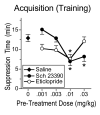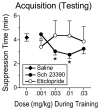Differential involvement of dopamine receptors in conditioned suppression induced by cocaine
- PMID: 17628537
- PMCID: PMC2039925
- DOI: 10.1016/j.ejphar.2007.06.037
Differential involvement of dopamine receptors in conditioned suppression induced by cocaine
Abstract
Cocaine-paired stimuli can suppress food-reinforced operant behavior in rats, providing an animal model of conditioned drug effects. To study the neuropharmacological basis of this phenomenon, we examined the effects of various dopamine receptor antagonists on the acquisition and expression of cocaine-induced conditioned suppression in rats. Superimposed on an ongoing baseline of food-reinforced operant responding, a stimulus was paired with response-independent cocaine (3.0 mg/kg, i.v.) during each of 8 training sessions. To study acquisition, independent groups of rats were given saline, the dopamine D(1)-like receptor antagonist R(+)-7-chloro-8-hydroxy-3-methyl-1-phenyl-2,3,4,5-tetrahydro-1H-3-benzazepine hydrochloride (SCH 23390) (0.001-0.03 mg/kg, i.p.), or the dopamine D(2)-like receptor antagonist eticlopride (0.001-0.03 mg/kg, i.p.) prior to each training session. To study expression, independent groups of rats were trained first, then given saline, SCH 23390, eticlopride, or N-[4-(4-(2-methoxyphenyl)piperazinyl)butyl]-2-naphthamide (BP 897) (a dopamine D(3) partial receptor agonist; 0.1-1.0 mg/kg, i.p.) before test sessions in which the stimulus was presented without cocaine. Pre-treatment with either SCH 23390 or eticlopride during acquisition reduced the direct suppressant effects of cocaine, but conditioning was blocked only in rats that were treated with SCH 23390 during acquisition training. Expression of conditioning was attenuated only by eticlopride. Thus, dopamine at least partially mediates both the acquisition and expression of cocaine-induced conditioned suppression, with activation of dopamine D(1)- and D(2)-like receptors underlying these respective processes.
Figures





Similar articles
-
D1-like and D2 dopamine receptor antagonists administered into the shell subregion of the rat nucleus accumbens decrease cocaine, but not food, reinforcement.Neuroscience. 2005;135(3):959-68. doi: 10.1016/j.neuroscience.2005.06.048. Epub 2005 Aug 19. Neuroscience. 2005. PMID: 16111825
-
Effects of dopamine indirect agonists and selective D1-like and D2-like agonists and antagonists on cocaine self-administration and food maintained responding in rats.Neuropharmacology. 2004;47 Suppl 1:256-73. doi: 10.1016/j.neuropharm.2004.07.007. Neuropharmacology. 2004. PMID: 15464142
-
Effects of dopamine D1 and D2 receptor antagonists on cocaine-induced place preference conditioning in preweanling rats.Eur J Pharmacol. 1995 Sep 5;283(1-3):125-31. doi: 10.1016/0014-2999(95)00309-9. Eur J Pharmacol. 1995. PMID: 7498301
-
Effects of SCH 23390 and eticlopride on cocaine-seeking produced by cocaine and WIN 35,428 in rats.Psychopharmacology (Berl). 2003 Jul;168(1-2):118-123. doi: 10.1007/s00213-002-1276-y. Epub 2002 Nov 5. Psychopharmacology (Berl). 2003. PMID: 12420155
-
Isolation rearing impairs the reinforcing efficacy of intravenous cocaine or intra-accumbens d-amphetamine: impaired response to intra-accumbens D1 and D2/D3 dopamine receptor antagonists.Psychopharmacology (Berl). 1994 Jul;115(3):419-29. doi: 10.1007/BF02245085. Psychopharmacology (Berl). 1994. PMID: 7871084
Cited by
-
Inactivation of ERK1/2 Signaling in Dopaminergic Neurons by Map Kinase Phosphatase MKP3 Regulates Dopamine Signaling and Motivation for Cocaine.J Neurosci. 2024 Jan 31;44(5):e0727232023. doi: 10.1523/JNEUROSCI.0727-23.2023. J Neurosci. 2024. PMID: 38296649 Free PMC article.
-
Cocaine-induced reinstatement in rats: evidence for a critical role of cocaine stimulus properties.Psychopharmacology (Berl). 2008 May;197(4):649-60. doi: 10.1007/s00213-008-1083-1. Epub 2008 Mar 3. Psychopharmacology (Berl). 2008. PMID: 18311560
References
-
- Adams JU, Careri JM, Efferen TR, Rotrosen J. Differential effects of dopamine antagonists on locomotor activity, conditioned activity and conditioned place preference induced by cocaine in rats. Behav Pharmacol. 2001;12:603–611. - PubMed
-
- Azzara AV, Bodnar RJ, Delamater AR, Sclafani A. D1 but not D2 dopamine receptor antagonism blocks the acquisition of a flavor preference conditioned by intragastric carbohydrate infusions. Pharmacol Biochem Behav. 2001;68:709–720. - PubMed
-
- Baker RM, Shah MJ, Sclafani A, Bodnar RJ. Dopamine D1 and D2 antagonists reduce the acquisition and expression of flavor-preferences conditioned by fructose in rats. Pharmacol Biochem Behav. 2003;75:55–65. - PubMed
-
- Beninger RJ, Miller R. Dopamine D1-like receptors and reward-related incentive learning. Neurosci Biobehav Rev. 1998;22:335–245. - PubMed
Publication types
MeSH terms
Substances
Grants and funding
LinkOut - more resources
Full Text Sources
Miscellaneous

